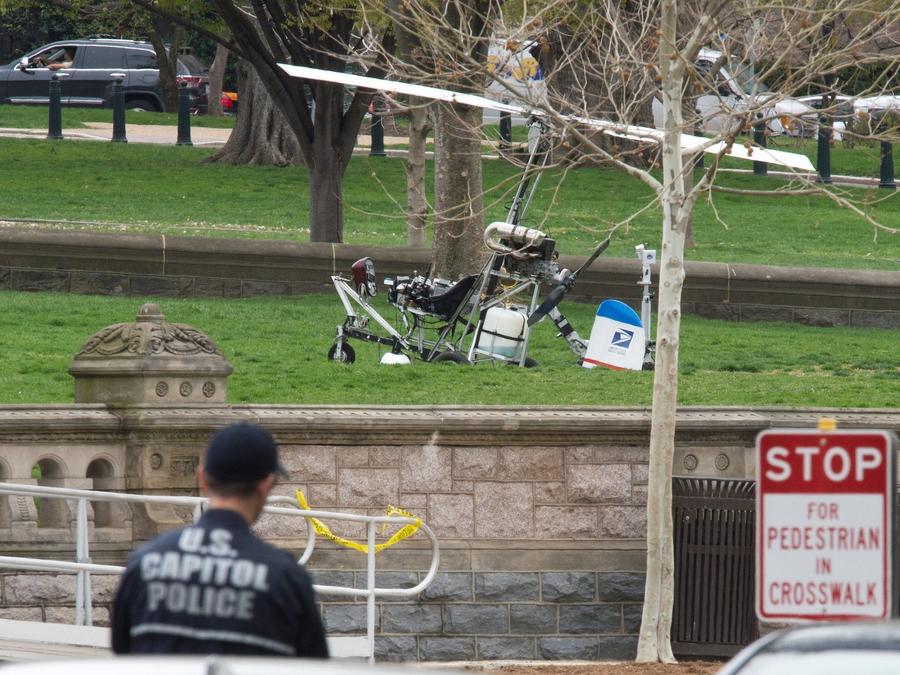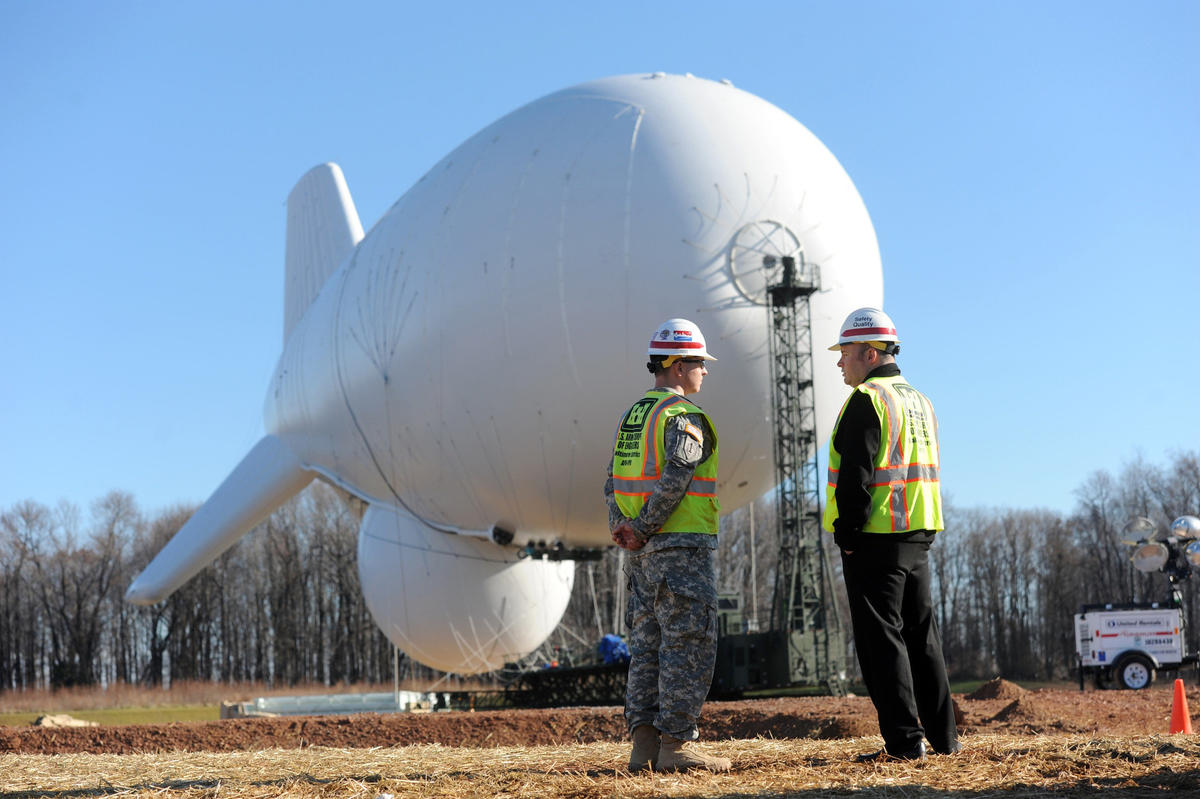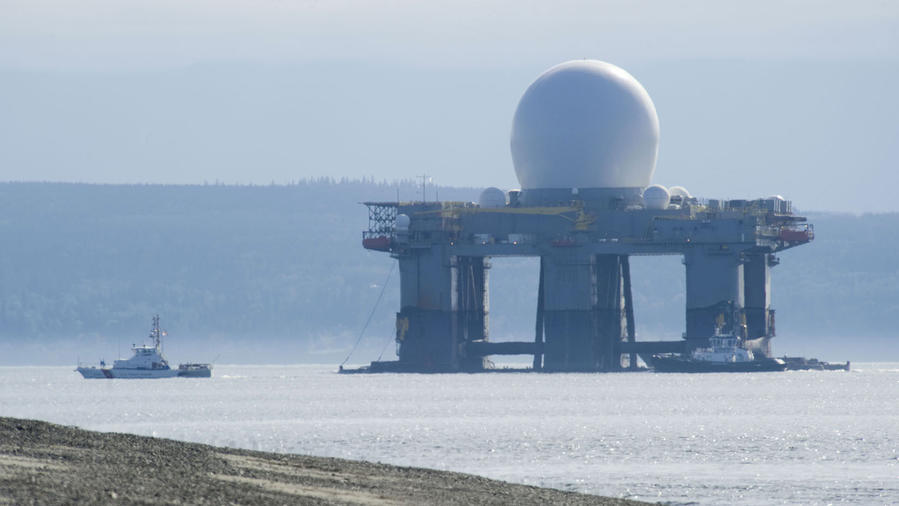Unknown to most Americans, the Pentagon has spent $2.7 billion developing a system of giant radar-equipped blimps to provide an early warning if the country were ever attacked with cruise missiles, drones or other low-flying weapons.
After nearly two decades of disappointment and delay, the system — known as JLENS — had a chance to prove its worth on April 15.
That day, a Florida postal worker flew a single-seat, rotary-wing aircraft into the heart of the nation’s capital to dramatize his demand for campaign finance reform.
JLENS is intended to spot just such a tree-skimming intruder, and two of the blimps were supposed to be standing sentry above the capital region. Yet 61-year-old Douglas Hughes flew undetected through 30 miles of highly restricted airspace before landing on the West Lawn of the U.S. Capitol.
At a congressional hearing soon afterward, Rep. Jason Chaffetz (R-Utah) demanded to know how “a dude in a gyrocopter 100 feet in the air” was able to pull off such an audacious stunt.

“Whose job is it to detect him?” Chaffetz asked.
It was JLENS’ job, but the system was “not operational” that day, as the head of the North American Aerospace Defense Command, Adm. William E. Gortney, told Chaffetz. The admiral offered no estimate for when it would be.
Seventeen years after its birth, JLENS is a stark example of what defense specialists call a “zombie” program: costly, ineffectual and seemingly impossible to kill.
In videos and news releases, Raytheon Co., the Pentagon’s lead contractor for JLENS, has asserted that the system is “proven,” “capable,” “performing well right now” and “ready to deploy today.”
A Los Angeles Times investigation found otherwise:
- In tests, JLENS has struggled to track flying objects and to distinguish friendly aircraft from threatening ones.
- A 2012 report by the Pentagon’s Operational Test and Evaluation office faulted the system in four “critical performance areas” and rated its reliability as “poor.” A year later, in its most recent assessment, the agency again cited serious deficiencies and said JLENS had “low system reliability.”
- The system is designed to provide continuous air-defense surveillance for 30 days at a time, but had not managed to do so as of last month.
- Software glitches have hobbled its ability to communicate with the nation’s air-defense networks — a critical failing, given that JLENS’ main purpose is to alert U.S. forces to incoming threats.
- The massive, milk-white blimps can be grounded by bad weather and, if deployed in combat zones, would be especially vulnerable to enemy attack.
- Even if all those problems could be overcome, it would be prohibitively expensive to deploy enough of the airships to protect the United States along its borders and coasts.
These findings emerged from a review of reports by the Pentagon testing office and the U.S. Government Accountability Office and from interviews with defense scientists and active and retired military officers.
Despite the system’s documented shortcomings, Raytheon and other backers of JLENS have marshaled support in Congress and at the highest levels of the military to keep taxpayer money flowing to the program.
They have done so in part by depicting JLENS as the answer to an ever-evolving list of threats: cruise missiles, drones and other small aircraft, “swarming” boats, even explosives-laden trucks.
Army leaders tried to kill JLENS in 2010, The Times learned. What happened next illustrates the difficulty of extinguishing even a deeply troubled defense program.
Raytheon mobilized its congressional lobbyists. Within the Pentagon, Marine Corps Gen. James E. “Hoss” Cartwright, then vice chairman of the Joint Chiefs of Staff, came to JLENS’ defense, arguing that it held promise for enhancing the nation’s air defenses.
At Cartwright’s urging, money was found in 2011 for a trial run of the technology — officially, an “operational exercise” — in the skies above Washington, D.C.
Cartwright retired the same year — and joined Raytheon’s board of directors five months later. As of the end of 2014, Raytheon had paid him more than $828,000 in cash and stock for serving as a director, Securities and Exchange Commission records show.
The Times sought comment from Raytheon and an opportunity to interview company officials about JLENS. In response, spokeswoman Keri S. Connors said by email that Raytheon “declines to participate in the story.”
Cartwright, who remains a Raytheon director, did not respond to messages seeking comment.
Philip E. Coyle III, who oversaw assessments of dozens of major weapons systems as the Pentagon’s director of operational testing from 1994 to 2001, said Congress should closely examine whether JLENS deserves any more taxpayer dollars.
The cost of a blimp-borne radar network extensive enough to defend the nation against cruise missiles “would be enormous,” Coyle said in an interview.
“When you look at the full system — all the pieces that are required — that’s when it gets really daunting,” he said.

JLENS is short for Joint Land Attack Cruise Missile Defense Elevated Netted Sensor System — Pentagon-speak for airborne radar that is linked, or “netted,” to the nation’s air-defense network.
The radar is kept aloft by pilotless, helium-filled airships, each 242 feet long. At the blimps’ maximum altitude of 10,000 feet, the radar can see 340 miles in any direction, far beyond the limits that Earth’s curvature imposes on land- or sea-based radar.
The blimps are designed to operate in pairs. One searches widely for threats. The other is supposed to focus narrowly on airborne objects and transmit “fire control” data on their location, speed and trajectory.
If JLENS were working as intended, U.S. fighter jets or ground-based rockets would use the fire-control data to intercept and destroy an intruder.
The 7,000-pound airships are anchored to the ground by high-strength, 1-1/8-inch-thick Kevlar tethers, which also hold wiring for electricity. A ground crew of about 130 is needed to operate a pair of blimps around the clock.
Military planners have long been intrigued by the idea of hovering surveillance platforms that would allow radar to see beyond the horizon and stand guard for long periods.
The Army awarded the first JLENS contract in 1998 to a joint venture led by Raytheon, for an estimated $292 million.
Raytheon, headquartered in Waltham, Mass., assembled the radar. The blimps and ground equipment were built by TCOM L.P., based in Columbia, Md. Numerous subcontractors provided other components and services.
The events of Sept. 11, 2001, seemed to validate the Army’s decision, demonstrating the potential for unconventional airborne attacks anywhere in the world, including the nation’s capital.
On that day, Al Qaeda operatives commandeered four commercial airliners, flying two into the World Trade Center in New York and a third into the Pentagon.
The hijackers intended to steer the fourth plane into the U.S. Capitol or the White House, but passengers rebelled and tried to break into the cockpit, according to the 9/11 Commission. The airliner nose-dived into a field in southwestern Pennsylvania, 20 minutes’ flying time from Washington.
In November 2005, the Army added $1.3 billion to Raytheon’s JLENS contract, and the government committed to buy 28 of the blimps.
But problems emerged with the software for the fire-control radar, causing repeated delays in testing and production.
Doubts also grew within the Army about whether JLENS — even if it could ever be made operational — would serve a real need.
Its original selling point was that it could be swiftly moved around within a battle theater. But that became implausible, given the extensive ground facilities required to support JLENS — including power generators and reinforced concrete pads to anchor the airships.
A more serious problem, from the standpoint of Army leaders, was that even a fully functioning JLENS would not be much use against the weapons that were killing and maiming U.S. troops in Iraq and Afghanistan: crude rockets, artillery and improvised explosive devices.
JLENS was designed chiefly to defend against cruise missiles, which were not a threat in those battle zones. And the U.S. already had radar-equipped planes that could detect cruise missiles.
A mishap at a test facility in Elizabeth City, N.C., operated by TCOM, further soured Army leaders on JLENS.

During a storm on Sept. 30, 2010, a civilian balloon broke loose from its mooring, destroying a grounded JLENS blimp that had cost about $182 million.
By then, the Pentagon had poured more than $2 billion into JLENS and did not have an operational system to show for it. Planners estimated it would take billions more to deliver JLENS as originally promised.
At the insistence of Gen. Peter W. Chiarelli, then the Army’s vice chief of staff, officials canceled plans to buy the full complement of 28 blimps and prepared to kill the program.
Chiarelli wanted the money spent on technologies that would defend against RAM — Army shorthand for rockets, artillery and mortar.
“I tried to kill it,” Chiarelli, now retired, said in an interview. “I did not see JLENS as an effective RAM counter-surveillance. I wanted somebody to realize that what was killing our soldiers was RAM and not cruise missiles.”
Raytheon sent into action a team of lobbyists that included former U.S. Sens. Trent Lott (R-Miss.) and John Breaux (D-La.), as well as two of their former Senate aides.
The company put forth an expanded rationale for JLENS, asserting that it could be used to protect not just troops in combat, but also American cities and towns.
The company put forth an expanded rationale for JLENS, asserting that it could be used to protect not just troops in combat, but also American cities and towns.
The list of threats to which JLENS was the answer grew as well. To missiles, drones and small aircraft,Raytheon added boats and “moving ground targets,” including tanks and trucks.
Inside the military, Cartwright and other JLENS supporters sought to overcome the Army’s opposition by arguing that the system could bolster “situational awareness” of airborne threats, adding a valuable capability to existing early-warning networks.
A 2011 Raytheon video echoed the point, saying that JLENS “provides revolutionary enhancements to ground and situational awareness.”
The video said the system would stand watch against “today’s real and persistent threats,” including planes and “rotary wing aircraft.” (Postal worker Douglas Hughes would fly just such a craft to the doorstep of Congress four years later.)
The military backers of JLENS also tapped into the lingering post-Sept. 11 concern that Washington remained vulnerable.
They proposed basing JLENS at Aberdeen Proving Ground in Maryland, an Army installation about 60 miles northeast of Washington, for a three-year trial run during which the system would protect the capital area and a surrounding swath of the eastern United States.
This offered members of Congress the prospect of increased surveillance of the region where they work and live.
It won the backing of Maryland’s senior senator, Barbara A. Mikulski, a Democrat who was head of the Senate Appropriations Committee and whose state was home to TCOM, the maker of the blimps.
The system’s backers depicted JLENS as a bargain, not a burden. They said it could provide continuous aerial surveillance at a fraction of what it would cost to keep the military’s radar planes in the air around the clock.
The rescue effort was fortified by JLENS’ broad economic footprint: The program has supported hundreds of blue- and white-collar jobs in Southern California, Massachusetts, Maryland, North Carolina, Texas, Alabama, New Mexico, Utah, Oregon and Virginia.
Nevertheless, Army leaders pushed back. They said that if Cartwright and others wanted to keep JLENS going, the Army should not be required to pay for it.
JLENS advocates responded by seeking some of what would be needed for the three-year test exercise from Defense Department research and development funds.
By the spring of 2011, the system’s supporters had prevailed in the Pentagon. Soon thereafter, Congress approved the funding.
JLENS would live on.
So would its stubborn technical problems.
In videos and other promotional materials, Raytheon has claimed that JLENS can provide nonstop protection.
“JLENS is always on. It provides 360 degrees of continuous surveillance — 24/7, 30 days at a time,” says the narrator of a 2012 video. “JLENS is proven, capable, cost-effective and ready.”
In fact, equipment malfunctions and weather conditions had prevented JLENS from operating continuously for as long as 30 days, as of the end of last month, according to Pentagon documents and defense specialists.
The Pentagon testing office’s 2012 report gave JLENS low marks, including for its ability to find and track a target — and to distinguish friendly aircraft from real threats.
The report also cited “software stability” problems affecting the all-important fire-control radar.
The deficiencies emerged during tests conducted at a range in Utah, about 80 miles southwest of Salt Lake City.
The report said JLENS had remained airborne and functional for an average of just 21 hours per launch.
It rated the system’s overall reliability as “poor.”
In its 2013 report, the operational testing office said JLENS had demonstrated “a potential capability” to relay radar data to U.S. forces during four experimental flights. In one of the tests, data from JLENS enabled a missile to destroy a target drone.
The flights, however, were made in an “operationally unrealistic test environment” and relied on “equipment that is not part of the JLENS system,” the report said.
The Pentagon specialists again noted that JLENS had been deficient in locating and consistently tracking targets — and in distinguishing friendly from potential enemy aircraft.
In addition, military personnel needed “significant contractor support” from Raytheon to run the system during tests, the report said. Troops would not have that luxury in combat.
Among the report’s conclusions: “JLENS system level reliability is not meeting program reliability growth goals. Both software and hardware reliability problems contribute to low system reliability.”
The report also said tests of the system’s ability to perform in the face of expected electronic interference from radios and other radars during an attack “revealed several anomalies affecting mission-critical systems.”
Referring to that vulnerability, the authors wrote: “JLENS did not demonstrate the ability to survive in its intended operational environment.”

The three-year operational exercise above the Washington area is costing taxpayers about $50 million a year.
Nearly $20 million was spent just to pour the massive concrete footings needed to anchor the airships, according to a congressional analyst who has tracked the program.
In announcing the test exercise in December, the North American Aerospace Defense Command (NORAD) said the first blimp would be deployed that month, “followed approximately six weeks later by the second.”
A Raytheon news release dated Dec. 27, 2014, said JLENS “is strategically emplaced to help defend Washington, D.C., and a Texas-sized portion of the East Coast.”
The first blimp went aloft in December. But software problems with the fire-control radar have kept the required second airship on the ground for most of this year.
That is how Douglas Hughes was able to fly his gyrocopter through Washington airspace, undetected.
A military spokeswoman, Army Maj. Beth R. Smith, said the difficulty in launching the second blimp involved “software issues” affecting the integration of JLENS data “into the NORAD air defense network.”
Smith was interviewed in late July. As of then, she said, JLENS was still not linked, or “netted,” to NORAD.
The second airship was briefly sent aloft Aug. 18 and again Aug. 22. Each flight lasted only about an hour, according to another spokeswoman, Air Force Maj. Katrina G. Andrews.
JLENS is now in a “testing and system checkout phase,” she said this month. Asked whether the system had yet been integrated into the NORAD network, Andrews declined to elaborate.
Robert M. Stein, a radar engineer and former Raytheon executive who serves on the Pentagon’s Defense Science Board, expressed doubt that JLENS would ever be feasible for broad-scale use.
Deploying the blimps widely enough to protect the country against cruise missiles would be impractical, he said in an interview. It would make more sense, Stein said, to invest in improved intelligence so that the U.S. could anticipate an attack and take preemptive action.
“It’s awfully expensive to be able to deal with a bolt out of the blue,” he said. “That’s almost an impossible job.”
Additional Credits: Development: Lily Mihalik. Lead image: JLENS blimps are intended to provide U.S. forces with early warning of cruise missiles or other low-flying enemy aircraft. Technical problems have prevented the system from performing reliably. (Raytheon)





